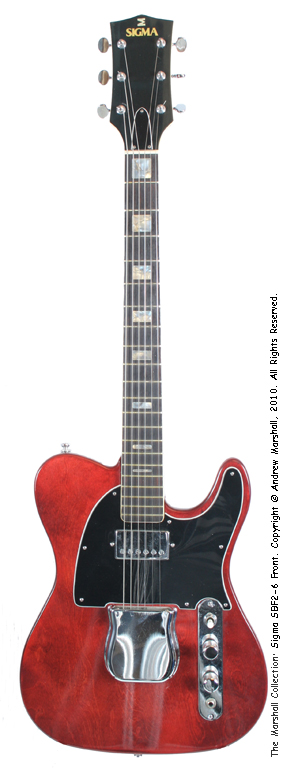 In 1970 Martin created the Sigma brand to manufacture instruments in Asia Pacific. Martin had no electric offering in the product line in the 1970’s, a boom time for the electric market.
In 1970 Martin created the Sigma brand to manufacture instruments in Asia Pacific. Martin had no electric offering in the product line in the 1970’s, a boom time for the electric market. By 1973, Martin had specified a series of solid electric guitars to complement the Sigma acoustic line. These are notable as they were the first solid body electric guitars sold by Martin (or a Martin owned company), all previous electrics having been archtops or thinlines.
These instruments were made by the highly respected Tokai in Japan, and were the only four models made in the period. They were only offered in the colors shown in the galleries here. However, these instruments were not created exclusively for Martin by Tokai, and virtually identical instruments were marketed by Ampeg as their ‘Stud’ line. It is not clear whether the Ampeg models predate the Sigma models or vice versa, but it is likely each were badge engineered versions of Tokai designs. The Sigma and Ampeg version differ only in headstock shape and logo, although interestingly the Ampeg range had more instruments in it than Sigma’s.
The four models were the SG-style cherry SBG2-6 and natural SBG2-9, the Telecaster like cherry SBF2-6, and the vaguely Telecaster bass like natural finish SBB2-8. These all had bolt on necks and 3 per side tuners, with Grover imperials on the high end SBG2-9. (The Ampeg equivalents were SBG2-6=Stud GE-100, SBG2-9=Super Stud GE500, SBF2-6=Heavy Stud GEHT50, and SBB2-8=Big Stud GEB-750)
These were extremely high quality instruments and relatively few were made and sold. Sadly, none of the factory records still exist and the instruments lacked serial numbers, so production totals are unavailable, but it would not be unreasonable to assume that only 150-250 of each model were produced given their short production run and relative scarcity.
Martin’s sales pitch – and it was a good one – in the advertising of the period was that the guitars were all inspected at the Martin factory in Nazareth PA before being sold in the US. The intent here was to offset the fear of potential quality issues in far eastern manufacture that still existed in the 70’s. However good an idea this was, the model range didn’t survive after 1974 and Martin itself would not dally with solid electric guitars again until the EM-18 in 1978, although electrics in the Goya line (also owned by Martin through it’s acquisition of Levin in 1974, although not marketed as ‘inspected by Martin in the USA’) produced Japanese solid electrics until at least 1977 (More to come on the Japanese Martin Goyas in later posts)
The Marshall collection has one example of each model as a key part of the Martin electric story, shown in the gallery here.
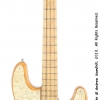
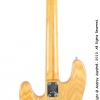
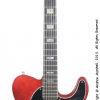
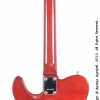
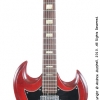
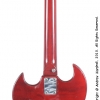
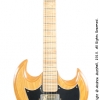
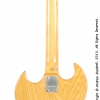











Hello Everyone,
I’m really excited to announce that I was helping my Father clean out some things from the garage and I found a SBF2-6 in great condition. HOWEVER, it is missing the bottom metal plate that covers where the strings are put in. I’m not much on guitars but I was trying to do something nice for my Dad and have the guitar fully restored and tuned by a professional. The problem is I can’t find that part ANYWHERE online. It looks like the guitar is so rare that just simply finding the whole guitar for sale is hard enough, let alone replacement parts. My Father is in the final stages of Cancer and I was hoping to get this done for him quickly. Anyone have any advice on where to find the part I need? You can email me at [email protected].
Thanks!
Thanks for the site! I bought the SBG2-9 back in 1978 new in Tampa when I was 14 years old and still have it, in fact, was playing it last night. I got to thinking about doing a google search today to find out more information about it. I had done this a few years back and found some pictures of one but little information. Thanks again, the two pictures you have there are exactly mine.. Cheers!
Hi there, thanks for stopping by, glad you’re from Hamburg, that’s my favourite German city!
I think what you have is a 1973/4 Goya Les Paul – one question, does it have mini humbuckers (like a Les Paul Deluxe)?
Andrew
What i forgot to say about the Les Paul. It is a standard with traditionell set neck/glued in.
Hi,
you also forget the Les Paul range.
Mahagony neck & body, maple top, slightly chambered.
I just bought one last month for 370€,-, frets are down, but well made instrument.
Just shaped the frets for the last time i guess.
Someone interested in ? > [email protected]
greets from Hamburg – rock on,
agy.040
Hi Tom, I’ve never seen/heard of a Sigma strat copy other than the Stinger – but then I’m finding things I didn’t know about previously all the time!
The only thing to be careful of is that just because it says Sigma on it, doesn’t mean it is – there is at least one factory that used that name and wasn’t anything to do with Martin.
Do you have any photos?
Andrew
I briefly had a Sigma Strat copy, which you don’t mention. I foolishly resold it, because the neck was a little too fat for me. But it had incredible, fat sounding pickups – although I don’t know for sure that they were original. They nailed SRV tone better than a set of Texas Specials I stuck in another old Strat copy. Anyway, wondering if you’ve heard anything else about Sigma Strats? I’ve been curious if maybe they used the same pups as the Martin Stinger, in which case I would consider getting one of those. I’m also thinking they must be really rare. I bought mine from a non-musician collector’s garage, and have maybe seen one other one on Ebay, whereas there are usually a couple of Stingers available.
Thank you a lot for that article. I’ve bought SBG2-6 and it was in terrible position, but sound is amazing! But a lack of history and limited production isn’t playing well for selling that guitar.
Thank you for your article!
Thank you for this page, it helps a lot. I have the SBB2-8 bass, in mint condition. I`m not looking to sell it, but would like to know about what it is worth,any idea?,Thank you.
[email protected]